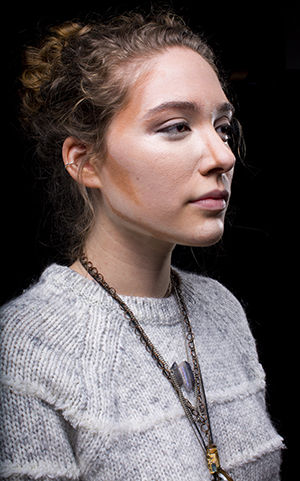Defining the lines of contouring

Senior fashion design major Libby Snyder in the process applying contouring make up to her face on Tuesday Feb. 2, 2015.
February 3, 2015
Contour [kon too r] n. the outline of a figure or body; the edge or line that defines or bounds a shape or object.
Once upon a time, contour lines only denoted thoughts of a thin line drawing. I must admit that I didn’t even know the modern meaning of contouring until a week ago. It wasn’t until I looked more into this craze that I was shocked by the drastic transformation it could have on people’s faces.
For those of you who don’t know, “contouring” is a practice traditionally used by makeup artists on runway models to create subtle definition to the structure of a model’s face and body. Thanks to plenty of aspiring makeup artists on YouTube, this trend is making its way to the masses.
At first, I was quite skeptical. I had never seen such an extensive makeup routine lead to anything that could appear natural. And the thought of wearing makeup all over one’s body, just to trick people into believing you’re perfectly toned, seemed like a waste of time and a recipe for orange-stained clothing. However, after researching a bit more, I realized the value that can be gained just by adding two powders and 10 more minutes to the morning routine. This practice is so subtle and creates the most dramatic transformation I’ve ever seen in makeup.
At its best, contouring conceals flaws and enhances preexisting features to appear more naturally obvious. At its worst, contouring can easily lead to wasted hours in front of the mirror only to look streaky and clownish. So, with the right combination of products and reliable YouTube tutorials, let the artistry begin.
What to do:
-Choose a matte contour and a shimmer highlight.
Avoid a shimmery contour color. It won’t blend with your natural skin tones.
-Choose the right shade.
Some artists suggest using a bronzer for shading. This seems to create more of a dramatic look for pale-skinned girls but will create a natural tone for tan ladies. Others suggest using your regular foundation in a few shades darker. Whichever method you choose, make sure to blend well.
-Choose the right brush.
Start with a small brush for precision, and blend with a fan brush around the hairline, cheekbones and jawline.
What not to do:
-Do not leave hard lines unblended, especially around the jawline.
The key is subtlety.
-Do not paint your face darker than the rest of your body.
This should be obvious. Make sure that your contour blends well with your natural coloring.
Honestly, I don’t see much reason in putting so much effort into defining a naturally beautiful face, outside of the professional sphere. However, the harsh reality is that a perfectly toned face will be more respected in the workplace than one that is tired and blotchy. We all could use a little help looking fresh from time to time. The perfect contour can create the illusion of flawless skin, toned features and a natural glow, which will exude confidence and composure when you need it most.
For a great tutorial on how to achieve the perfect contour, watch this Youtube video by Lisa Eldridge: https://www.youtube.com/watch?v=D8g3orq4M7U.
Contact Ellen Freeborn at [email protected].











